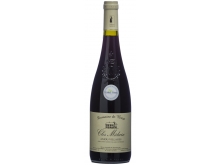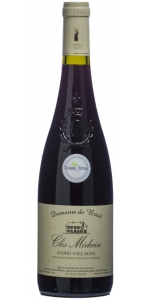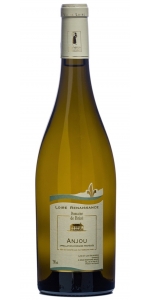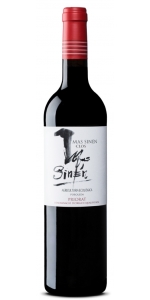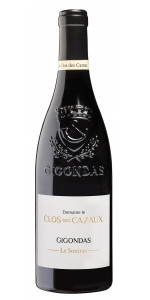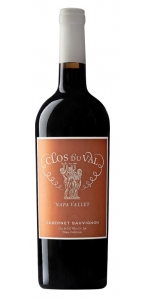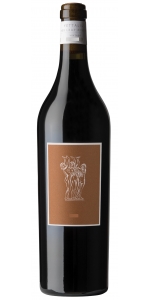Brize Clos Medecin Anjou Villages 2018
| Country: | France |
| Region: | Loire |
| Winery: | Domaine de Brize |
| Grape Type: | Cabernet Franc |
| Organic: | Yes |
| Vintage: | 2018 |
| Bottle Size: | 750 ml |
Brize Clos Medecin Anjou Villages Rouge is made from 60% Cabernet Franc and 40% Cabernet Sauvignon.
This is the flagship of the Estate. Clos Medecin has been produced at the estate for 90 years. All the grapes for this wine come from a very special parcel. The wine offers red fruit aromas. It is fresh, round and ample in the mouth.
Brize Loire Renaissance Anjou Blanc is made from 100% Chenin Blanc.
Anjou Blanc Renaissance was entirely fermented and aged in French oak barrels. The wine is dry and powerful with an intense bouquet of apricot, vanilla and honey.
Excellent when paired with lobster or white fish with a creamy sauce.
Mas Sinen Clos Priorat is made from 38% Garnacha, 22% Cabernet Sauvignon, 23% Carinena, 16% Syrah.
Before the 2017 vintage, this wine was called Negre. It is the same vinification and level of excellence as the prior cuvee, but with a different name.
It's quite ripe, concentrated, powerful and oaky with black rather than red fruit and peat and graphite aromas. The palate is full-bodied with plenty of rough-hewn tannins and moderate acidity, and is in need of bottle age and/or powerful food. An XXL Priorat.
Clos des Cazaux Gigondas Le Souiras is 100% Grenache.
“Le Souiras” is the terroir located at the very South end of the Gigondas appellation. Here, in the midst of the Dentelles de Montmirail, an extraordinary calcareous massif, we planted grapevines on slopes surrounded by Mediterranean vegetation.
We are situated at an altitude of 250 meters, where the nights are cooler. The terroir is stony with a layer of grey and blue clay under the topsoil. The slopes face West and are protected from the strong summer sun by the Montmirail hill. Due to this ideal microclimate, our old Grenache grapevines contain all the complexity and balance of this sunny terroir.
Color : Dark intense ruby color.
Bouquet : Notes of little red fruits, white pepper, caramel and juniper.
Palate : The first impression is arresting and generally qualified as round, complex and dense.
The aromas of black cherry, mocha and white pepper are very intense. The palate is powerful, elegant and velvety.
The finish is long, with very silky tannins and a very slight bitterness that gives this exceptional Grenache an impression of freshness.
Review:
"A brilliant wine that has so much to love, the 2022 Gigondas Le Souiras is all Grenache that was brought up in barrels. It exhibits a vivid ruby hue as well as classic kirsch and blackberry fruit intermixed with peppery garrigue, spice, and ample Provençal nuances. This medium-bodied, fresh, focused 2022 has a beautiful sense of elegance, fine tannins, and the balance to evolve gracefully over the coming 10-12 years."
- Jeb Dunnuck (December 5th 2024), 94 pts
Clos du Val Estate Cabernet Sauvignon is made from 6% Cabernet Sauvignon, 7% Merlot, 5% Malbec and 1% each Cabernet Franc and Petit Verdot.
This fresh and vibrant Napa Valley Cabernet Sauvignon is brimming with aromas of blackberry, mulberry, cassis, and violet. On the palate, bright flavors of cranberry, red plum, cherry, and lavender are intertwined with supple tannins, balanced acidity, and a long, smooth finish.
Review:
"Sleek tannins, guided by sweet earth, slate, purple plum and black olive. Savory notes of fig, toasted cedar, and black tea meld with blackberries. Well structured and impeccably balanced."
-Tasting Panel 96 Points
Clos Du Val Yettalil is a Bordeaux blend of Cabernet Sauvignon with Merlot, Cabernet Franc, Petit Verdot and Malbec
The 2019 Yettalil opens with aromas of fresh blackberry, ripe plum, and racy cassis layered with hints of violet, bay leaf, and thyme. Beautifully balanced and elegant on the palate, vibrant acidity and polished tannins give way to a concentrated core of black cherry, vanilla, and cedar. The texture is velvety and plush with a backbone of graphite and dark chocolate that lingers through a long finish.
Review:
The 2019 Yettalil is a blend of Cabernet Sauvignon, Merlot, Cabernet Franc, Petit Verdot, and Malbec. Deep garnet-purple in color, it charges out with energetic notes of crushed black and red currants, warm black plums, and black raspberries, plus suggestions of cedar, violets, and Indian spice with a waft of tree bark. The medium to full-bodied palate is lively and well-structured, featuring firm, ripe tannins to frame the muscular fruits, finishing on a lingering fragrant earth note.
-Wine Independent 95 Points
Brize Clos Medecin Anjou Villages is made from 60% Cabernet Fran and 40% Cabernet Sauvignon.
This is the flagship of the Estate. los Medecin has been produced at the estate for 90 years. All the grapes for this wine come from a very special parcel. The wine offers red fruit aromas. It is fresh, round and ample in the mouth.
Pairs with red meat, cheese, and barbecue.
Review:
"Lightly mulled dark cherry fruit flavors mix with tobacco, olive and sanguine notes, ending with a flicker of bay on the chalk-lined finish. Cabernet Franc and Cabernet Sauvignon. Drink now through 2022. 2,100 cases made, 50 cases imported. - JM"
- Wine Spectator (December 2021), 90 pts
Domaine de Brize is located in the town of Terranjou, in the Maine-et-Loire department of the Loire Valley. The 40 hectare-estate was born in the middle of the 18th century, founded by the Delhumeau family. The winery strived between the two world wars under the leadership of Pierre, a young, innovative, ingenious and combative man who compensated the loss of his mutilated hand during the War. He transmitted his passion for wine to his grandson Marc who followed in his footsteps and ran the property for 30 years, with the assistance of his two brothers. His son Luc joined the family estate in 1989, then his daughter Line came on board in 1992 together with her husband Didier. Brother and sister Luc and Line represent the 5th generation of the family winemakers and the 9th generation in the farm.
The vineyard is planted on highly diversified soils dominated by silico-clay, shale-sandstone and faluns. The viticulture practices meet the 'Terra Vitis' approach in respecting nature, people, the environment and the soil.
- back
Jean-Michel Sorbe Quincy Blanc is made from 100 percent Sauvingon Blanc.
The first nose is expressive and opens up to notes of acacia, citrus (lemon, grapefruit). Full on the palate with lovely freshness. This wine boasts nice balance and good length.
The vines are 15 to 20 years old and are located on the left bank of the Cher River, southwest of Quincy. This vineyard enjoys good exposure to the sun and overlies hillocks composed of sandy alluvial deposits and gravel dating back to the Quaternary Period. Each terroir is managed with minimal intervention in an environmentally friendly approach. Vinification: Slow pressing. Fermentation took place under controlled temperatures (18°C).The wine was aged on fine lees for a minimum of 4 months. It was filtered only once before being bottled.
Pair with crustaceans, asparagus, or goat's cheeses.
After pouring, allow the wine to breathe for a few moments in the glass before enjoying so that it may fully release all of its aromas.
Larroque Bordeaux Blanc is made from 73% Sauvignon Blanc and 27% Colombard.
No oak.
Color : Pale yellow with green tints.
Nose : Complex aromas of white flowers, exotic fruits, citrus and boxwood, with a touch of minerality.
Mouth : Aromatic, with a nice richness and freshness. Predominant flavors of tart, crisp fruit.
Marie-Christine, the daughter of Henri Ducourt, purchased this prestigious left-bank property in 1979, which lies on the border of the Graves appellation.
The 60-hectare vineyard was rapidly replanted and the château building, which dates from 1348, was restored.
Our family now produces three different-colored wines there: red, white and rosé.
Grown on loamy-clay soil.
Harvest : Machine harvesting in the cool, early morning
Maceration : Skin-contact maceration for several hours, depending on ripeness, and pressing
Fermentation : Beginning of the cold alcoholic fermentation (12°C / 53°F) then an increase in temperature to finish the fermentation at 20°C / 68°F.
Enjoy this wine as an aperitif or during the meal with fish, seafood or chicken salad.

